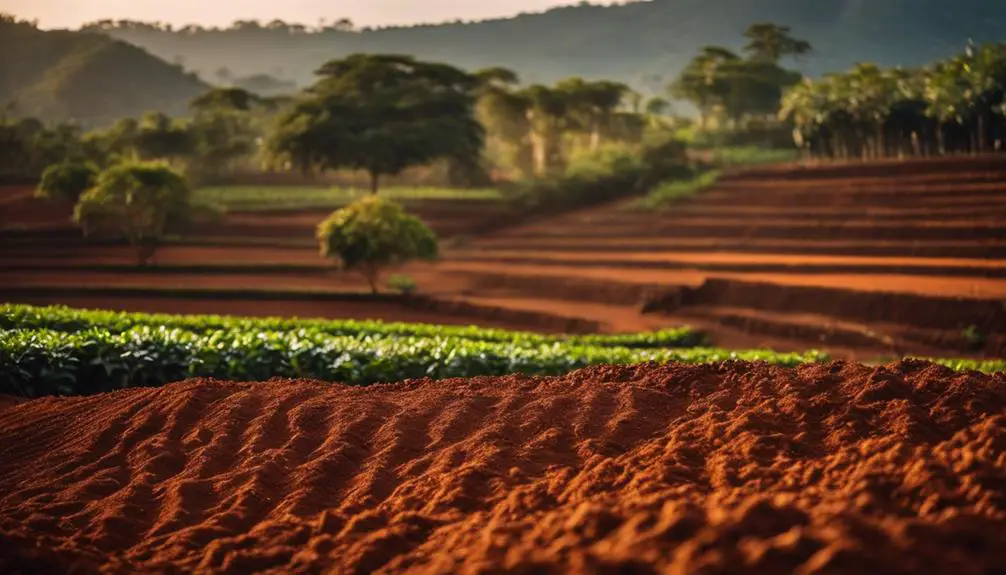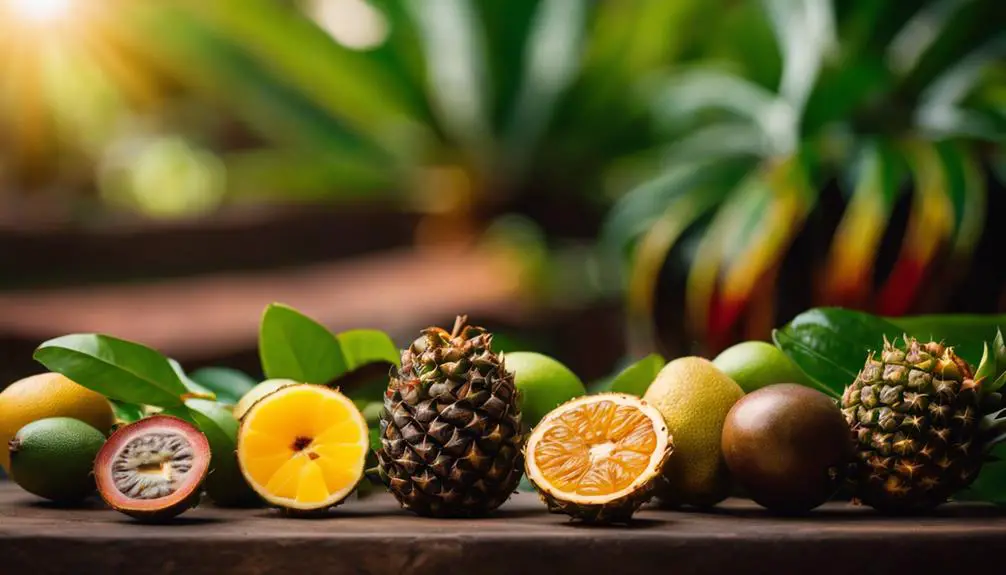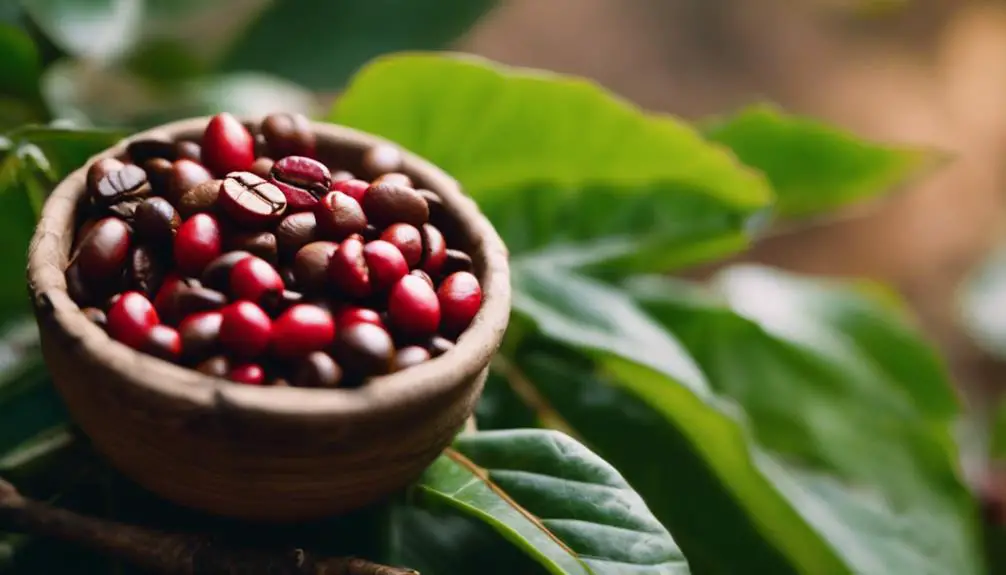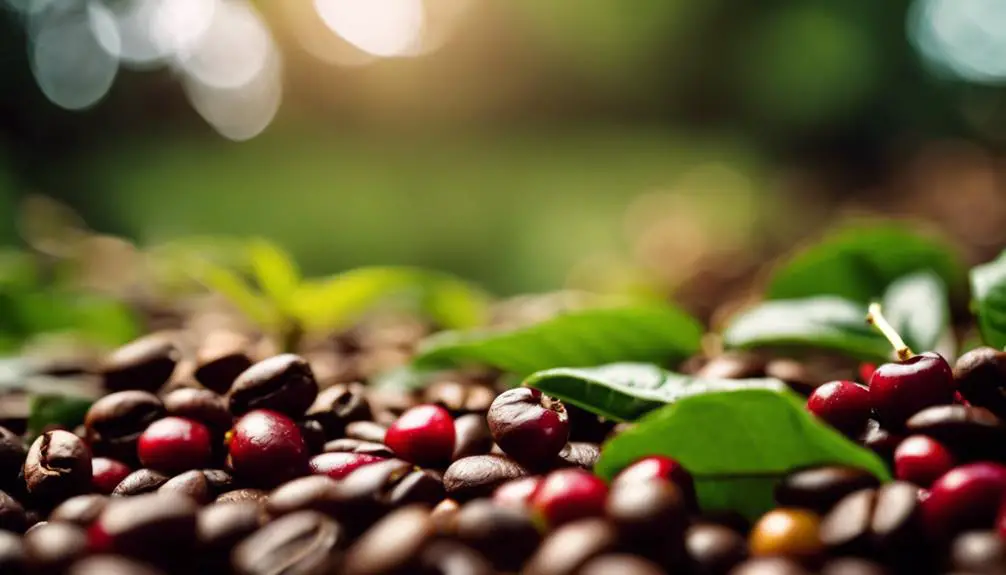When it comes to coffee acidity, regions around the world offer a diverse range of flavors, from bold and bright to mellow and smooth.
Ever wondered which region boasts the highest acidic coffees compared to those with the lowest acidity levels? Explore the intricate nuances that different coffee-growing regions bring to your cup, and uncover the surprising factors that influence the acidity of your daily brew.
The discussion on coffee acidity by region is a journey through a world of taste waiting to be discovered.
Exploring the Acidity of African Coffees

When it comes to African coffees, get ready to experience a spectrum of acidity profiles. Ethiopian coffees boast a captivating acidity that dances on your taste buds.
Kenyan coffees, on the other hand, offer a harmonious blend of bright acidity that’s truly a delight.
And don’t overlook Rwandan coffees; their acidity might just surprise you with its unique charm.
The Unique Acidity of Ethiopian Coffees
Exploring the unique acidity of Ethiopian coffees reveals a distinct and vibrant flavor profile that sets them apart from other African coffees. Ethiopian coffees are renowned for their unique profiles, deeply rooted cultural significance, and the various brewing techniques that enhance their flavors. The acidity variances in Ethiopian coffees contribute to their complexity, ranging from bright and fruity to more subtle and tea-like notes. Here is a comparison of some popular Ethiopian coffee varieties:
| Coffee Variety | Flavor Profile |
|---|---|
| Yirgacheffe | Floral, Citrusy |
| Sidamo | Berry, Wine-like |
| Harrar | Spicy, Fruity |
| Limu | Balanced, Clean |
| Jimma | Earthy, Herbal |
Kenyan Coffees: A Symphony of Bright Acidity
Kenyan coffees exhibit a symphony of bright acidity that distinguishes them as a standout among African coffees. The flavor profiles of Kenyan coffee are often described as vibrant and complex, with pronounced fruity and floral notes that are enhanced by their high acidity levels. When it comes to brewing techniques, many coffee enthusiasts recommend methods like pour-over or Aeropress to highlight the acidity without overpowering the delicate flavors. Roasting styles for Kenyan coffees are typically light to medium to preserve the bright acidity and intricate taste profiles. Here is a table that summarizes the essence of Kenyan coffees:
| Flavor Profiles | Brewing Techniques | Roasting Styles |
|---|---|---|
| Vibrant & Fruity | Pour-over | Light to Medium |
| Complex & Floral | Aeropress | |
| High Acidity |
Rwandan Coffee Acidity: A Hidden Gem
Rwandan coffee acidity, often hailed as a hidden gem among African coffees, presents a captivating sensory experience with its unique flavor profile. When exploring Rwandan acidity flavors, you’ll discover a delightful balance of bright and fruity notes that set it apart in the coffee world. The acidity trends in Rwanda showcase a rising preference for complex yet smooth profiles that intrigue the palate. Let’s delve deeper into the fascinating world of Rwandan coffee acidity with the table below:
| Acidity Level | Flavor Notes |
|---|---|
| High | Citrus, Black Tea |
| Medium | Apple, Caramel |
| Low | Nutty, Chocolate |
Rwandan coffee is a must-try for those seeking innovation and a truly unique coffee experience.
The Acidity Spectrum of Central American Coffees

Central American coffees offer a diverse range of acidity profiles.
Costa Rican coffees are known for their citrus and vibrant acidity, while Guatemalan coffees boast a rich and diverse acidity.
Honduran coffees, on the other hand, are gaining recognition as the rising star in the Central American acidity spectrum.
Costa Rican Coffees: Citrus and Vibrant Acidity
When exploring the acidity spectrum of Central American coffees, Costa Rican coffees stand out for their distinct citrus notes and vibrant acidity. These beans are renowned for their exceptional balance of citrus notes and acidity, creating a vibrant and lively cup of coffee. The flavor profiles of Costa Rican coffees often include bright and zesty undertones that awaken your taste buds with each sip. The acidity balance in these beans is carefully crafted to enhance the overall taste experience, making them a favorite among coffee enthusiasts seeking a refreshing and invigorating brew. Enjoy the lively acidity and citrusy notes of Costa Rican coffees as they transport you to the lush coffee plantations of Central America.
| Citrus Notes | Vibrant Acidity | Flavor Profiles |
|---|---|---|
| Distinct | Exceptional | Bright |
| Zesty | Lively | Refreshing |
| Balanced | Invigorating | Lush |
Guatemalan Coffee Acidity: Rich and Diverse
Exploring the rich and diverse acidity of Guatemalan coffee beans reveals a spectrum of flavors unique to Central American coffees. Guatemalan coffee beans are known for their vibrant acidity, ranging from bright and lively to smooth and mellow. The flavor profiles of Guatemalan coffees often include notes of citrus, chocolate, and floral undertones, making them a favorite among coffee enthusiasts seeking complexity in their brews. These beans thrive in the diverse microclimates of Guatemala, resulting in a wide range of acidity levels that cater to different preferences. Whether you prefer a light roast with pronounced acidity or a darker roast with a smoother profile, Guatemalan coffee beans offer a versatile experience that can be enjoyed through various brewing methods.
| Flavor Profiles | Acidity Levels |
|---|---|
| Citrus | High |
| Chocolate | Medium |
| Floral | Low |
| Nutty | Varied |
Honduran Coffee Acidity: The Rising Star
With its distinct flavor profile and growing popularity, Honduran coffee acidity is emerging as a notable contender in the spectrum of Central American coffees. The acidity trends of Honduran coffee are on the rise, captivating the palates of coffee enthusiasts worldwide. Known for its bright and lively acidity levels, Honduran coffee offers a delightful array of flavor notes ranging from citrus and apple to caramel and chocolate undertones. This dynamic combination creates a harmonious balance that has been instrumental in the growing popularity of Honduran coffee. As coffee connoisseurs seek new and innovative taste experiences, the acidity levels of Honduran coffee continue to elevate its status in the realm of specialty coffees.
| Flavor Notes | Acidity Level | Popularity Trend |
|---|---|---|
| Citrus | High | Increasing |
| Apple | Moderate | Steady |
| Caramel | Low | Rising |
South American Coffees and Their Acidity Profiles

When exploring South American coffees and their acidity profiles, you’ll find that Colombian beans offer a mild acidity with a touch of sweetness, making them a popular choice among coffee enthusiasts.
On the other hand, Peruvian coffee beans showcase the gentle acidity characteristic of Andean coffees, providing a unique flavor profile to savor.
These distinct acidity profiles from Colombia and Peru highlight the diversity and richness of South American coffee offerings.
Colombia: Mild Acidity with a Hint of Sweetness
Colombian coffee is renowned for its mild acidity that carries a subtle hint of sweetness, distinguishing it among South American coffees. The sweet acidity of Colombian coffee offers a balanced flavor profile that captivates coffee enthusiasts worldwide. Below is a comparison table showcasing the acidity levels of different South American coffees:
| Coffee Origin | Acidity Level |
|---|---|
| Colombia | Mild |
| Brazil | Low |
| Peru | Medium |
| Ecuador | Medium-High |
Colombian coffee stands out with its delicate acidity and sweet undertones, making it a favorite choice for those seeking a harmonious and flavorful coffee experience. The balanced taste of Colombian coffee is a result of its unique growing conditions and meticulous processing methods.
Peru: The Gentle Acidity of Andean Coffees
Peru’s Andean coffees are known for their gentle acidity that sets them apart in the realm of South American coffee varieties. When it comes to Andean coffee flavors, you can expect a delightful balance of subtle acidity and smooth body that reflects the unique terroir of the region. The mountainous coffee profiles of Peru offer a distinct taste that is often described as bright and crisp, with notes of citrus and floral undertones. Here is a comparison table showcasing the acidity levels of different South American coffee regions:
| Region | Acidity Level |
|---|---|
| Peru | Gentle |
| Colombia | Mild |
| Brazil | Low |
| Ecuador | Medium |
| Venezuela | High |
North American Coffees: The Acidity of Kona Coffee
When you sip Kona coffee, you’re tasting the influence of the volcanic soil on its acidity.
The unique combination of minerals found in this Hawaiian region gives Kona coffee its distinct flavor profile.
You’ll notice a bright and vibrant acidity that sets it apart from other North American coffees.
Kona: The Volcanic Earth’s Influence on Coffee Acidity
The volcanic soil of Kona, Hawaii, plays a crucial role in shaping the unique acidity profile of its coffee beans. Kona coffee’s flavor is a direct result of the volcanic terrain and the acidity correlation it brings to the beans. The volcanic acidity dynamics not only lend a distinct taste but also contribute to the overall quality of the brew. Below is a table that highlights the acidity levels of Kona coffee compared to other renowned coffee regions:
| Coffee Region | Acidity Level |
|---|---|
| Kona, Hawaii | High |
| Ethiopia | Medium |
| Colombia | Medium |
| Brazil | Low |
The volcanic influence on Kona coffee sets it apart, offering a vibrant and lively acidity that excites the taste buds and showcases the essence of its origin.
Regions Known for Lower Acidity Coffees

When it comes to regions known for lower acidity coffees, you’ll find that some Brazilian coffees offer a smooth acidity that’s not too sharp on the palate. Additionally, Indonesian coffees are often praised for their earthy flavors and low acidity levels, making them a popular choice among those who prefer a milder coffee taste.
Exploring these regions can lead you to discover a whole new world of coffee profiles that cater to a different preference for acidity.
The Smooth Acidity of Some Brazilian Coffees
Smoothly balancing on the palate, some Brazilian coffees are celebrated for their gentle acidity, distinguishing them in regions known for lower acidity profiles. These coffees offer a unique experience with their nuanced flavors and exceptional acidity balance. Here is a comparison table showcasing the distinct characteristics of Brazilian coffees:
| Flavor Profile | Acidity Level | Notes |
|---|---|---|
| Nutty | Low | Subtle sweetness |
| Chocolatey | Low | Rich and smooth |
| Caramel | Low | Velvety mouthfeel |
Brazilian coffees stand out for their smooth acidity, making them a favorite among those who prefer a milder yet flavorful coffee experience. Enjoy the delicate balance of flavors in each cup of Brazilian coffee.
Indonesian Coffees: Earthy and Low Acidity
Celebrating the earthy tones and low acidity of Indonesian coffees adds depth to your coffee tasting experience. Indonesian coffees are renowned for their rich earthiness and mellow acidity levels, offering a unique flavor profile that sets them apart. The earthiness in coffee from regions like Sumatra and Java provides a robust and full-bodied experience, perfect for those who appreciate a more grounded taste. Here’s a comparison table showcasing the acidity levels in Indonesian coffees compared to other regions:
| Region | Acidity Level | Flavor Profile |
|---|---|---|
| Indonesia | Low | Earthy, robust |
| Brazil | Medium | Nutty, smooth |
| Ethiopia | High | Floral, fruity |
| Colombia | Medium-High | Balanced, vibrant |
Comparative Analysis of Coffee Acidity by Region

Let’s compare the acidity levels of coffee from different regions.
Which countries produce the most acidic coffee, and which ones have the least acidic?
Understanding the variations in acidity can help you choose the perfect cup of coffee tailored to your preferences.
High Acidity Coffee Regions vs. Low Acidity Coffee Regions
When exploring coffee acidity by region, it becomes evident that certain regions produce high acidity coffees while others are known for their low acidity varieties. The interplay between climate and terroir significantly influences the acidity levels in coffee beans. Here is a comparison between high acidity coffee regions and low acidity coffee regions:
| High Acidity Coffee Regions | Low Acidity Coffee Regions |
|---|---|
| Ethiopia | Brazil |
| Kenya | Sumatra |
| Colombia | Guatemala |
These regions showcase the diverse range of acidity levels found in coffee, offering unique flavor profiles that cater to different preferences. The dynamic relationship between environmental factors and coffee acidity continues to intrigue coffee enthusiasts worldwide.
Which Country Has the Most Acidic Coffee?
In the realm of coffee acidity, pinpointing the country with the most acidic coffee can be an intriguing task. When considering acidity levels on a global scale, you might be surprised to learn that:
- Ethiopia, known as the birthplace of coffee, boasts some of the highest acidity levels in its beans.
- Colombia, with its diverse growing regions, is another country recognized for the sharp acidity present in its coffee.
- Kenya, celebrated for its bright and zesty flavors, also ranks high in terms of acidity when compared to other coffee-producing nations.
Exploring these global comparisons reveals the diverse range of acidity levels found in coffees worldwide, offering a tantalizing journey for those seeking innovative and bold flavors.
Regions with the Least Acidic Coffee
Regions renowned for their milder acidity levels in coffee beans offer a distinct contrast to the vibrant tang found in other coffee-growing areas. When exploring regions with the least acidic coffee, you’ll find a delightful balance that enhances the overall flavor profile. Here’s why these regions stand out:
- Smooth Experience: Enjoy a velvety cup without the sharp acidic notes.
- Subtle Nuances: Discover intricate flavors that shine through without overwhelming acidity.
- Mellow Aroma: Immerse yourself in a gentle, fragrant experience that complements the balanced acidity.
Experience a new side of coffee with these regions that prioritize a harmonious blend of flavors and acidity levels.
Factors Influencing Coffee Acidity

When it comes to coffee acidity, factors like soil composition play a crucial role.
The altitude at which coffee is grown can also significantly impact its acidity levels.
Additionally, seasonal variations can influence the acidity of coffee beans.
Soil Composition and Its Impact on Acidity
Examining the soil composition of different coffee-growing regions reveals a direct correlation between acidity levels and specific mineral content. When it comes to the impact of soil composition on coffee acidity profiles, consider the following:
- Mineral-Rich Soils: Regions with soils rich in minerals like phosphorus and potassium tend to produce coffees with a vibrant acidity that’s both complex and engaging.
- Volcanic Soils: Coffees grown in volcanic soils often exhibit a bright and lively acidity, attributed to the unique mineral composition of these fertile grounds.
- Organic Matter: Soil rich in organic matter can enhance acidity levels in coffee, providing a nuanced and refreshing taste experience that captivates the palate.
Understanding how soil composition influences acidity can lead to the discovery of new and exciting flavor profiles in the world of coffee.
The Highs of Altitude on Coffee Acidity
Exploring the impact of altitude on coffee acidity unveils a crucial factor that significantly influences the flavor profile of coffee beans. When it comes to altitude and coffee acidity, consider the following:
- Elevated Acidity Levels: Higher altitude regions often produce beans with brighter and more pronounced acidity, adding a delightful tanginess to your cup.
- Enhanced Flavor Development: The cooler temperatures at higher altitudes slow down the maturation process of coffee cherries, leading to more complex and flavorful beans.
- Geographical Influences: Different altitudes around the world contribute to unique acidity profiles, showcasing the diverse range of flavors coffee has to offer.
Altitude plays a pivotal role in shaping the acidity levels and overall taste experience of your coffee, making it an essential factor to consider when exploring new brews.
Seasonal Variations and Their Influence on Acidity
Seasonal variations play a significant role in influencing the acidity levels of coffee beans. When it comes to the acidity of coffee beans, the changing seasons can have a profound impact.
Here are three ways in which seasonal variations affect the acidity levels in coffee beans:
- Temperature Fluctuations: The varying temperatures throughout the year can alter the rate at which coffee cherries ripen, impacting the final acidity of the beans.
- Rainfall Patterns: Different rainfall patterns can affect soil moisture levels, which in turn influence how coffee plants absorb nutrients, ultimately impacting acidity.
- Sunlight Exposure: The duration and intensity of sunlight can impact the development of flavors in coffee beans, including acidity levels.
Understanding these seasonal influences can lead to innovative approaches in cultivating coffee beans with specific acidity profiles.
The Role of Processing Methods and Roast Levels

When it comes to coffee acidity, the processing methods and roast levels play a crucial role.
The way coffee beans are processed, whether washed or natural, can impact the acidity levels in the final cup.
Additionally, the roast level, be it light or dark, also influences how acidic the coffee will taste.
Acidity in Coffee Processing Methods: Washed vs. Natural
How do coffee processing methods like washed and natural affect the acidity levels in your cup? When comparing washed vs. natural processing:
- Washed Processing:
- Enhances clarity and brightness in flavor profiles.
- Results in a cleaner cup with pronounced acidity levels.
- Often brings out floral and fruity notes in the coffee.
These distinctions offer a vibrant and dynamic experience for coffee enthusiasts seeking innovative flavors. Additionally, the roast levels play a crucial role in shaping the acidity perception and taste nuances of the final brew. By understanding these nuances, you can further elevate your coffee journey, exploring a spectrum of flavors that cater to your unique preferences.
Light vs. Dark Roasts: How They Affect Acidity
Exploring the impact of light versus dark roasts on acidity levels in coffee reveals the intricate interplay between processing methods and roast profiles. When it comes to acidity:
- Light roasts often showcase higher acidity levels, offering vibrant and complex flavor notes that excite the palate.
- Dark roasts tend to have lower acidity levels, resulting in a smoother and more mellow taste profile that appeals to those seeking a rich and bold coffee experience.
- Experimenting with different brewing techniques can further enhance or balance the acidity in both light and dark roasts, allowing you to customize your coffee to suit your preferences.
Embrace the diversity of roast profiles and acidity levels to elevate your coffee-drinking experience with each cup.
Conclusion
So, there you have it – the world of coffee acidity is a diverse and flavorful one. From the bright and zesty African coffees to the smooth and mellow Central American brews, each region brings its own unique twist to the table.
Just like a symphony of flavors dancing on your taste buds, exploring the acidity of different coffee regions is like taking a musical journey through a world of delicious possibilities.
So go ahead, sip, savor, and enjoy the acidity adventure!

















